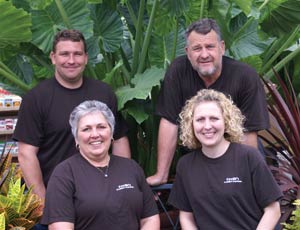6/15/2009
Defining Your Differences
Barbara Mulhern

Bruce Sadowski isn’t afraid to be unconventional.
Bruce, co-owner of Groth’s Country Gardens in Cedarburg, Wisconsin, has found that putting high-priced plants in what many would consider “wasted space,” custom planting large pots and offering a different type of fundraiser can result in increased customers and sales.
“Don’t be afraid of the bigger aisles and the bigger pots and putting them in front of people,” suggests Bruce, who with his wife, Elaine, owns the greenhouse and floral business they purchased in 1983. “Last year we had a broken growing bench that I was going to get rid of. Instead, we made it bigger and dedicated it to expensive items. We had a couple of plants in the $500 range that we sold just by putting them in this little area between the flower shop and the greenhouse—an area that could be perceived as a waste of space,” he says.
Groth’s, which was founded in 1928, has undergone many changes over the years. Bruce began working at Groth’s in 1966 and later married Elaine, one of the then-owners’ daughters, and the two became the third generation of family members involved in the greenhouse and floral operation. Today, Elaine’s mother, Laverne, continues to help out. Son Paul is head grower and daughter Jennifer Wollner is what Bruce calls “a jack of all trades.”
Groth’s is approximately 70% retail and 30% wholesale. Retail customers are primarily middle- to upper-income homeowners in the area. Wholesale customers include small garden centers and roadside stands.
Differentiation
Despite its location in Wisconsin, Groth’s is open year-round. In addition to year-round floral sales, they grow poinsettias for Christmas and sell vegetative plugs to other greenhouses during the cold January, February and March months. “We grow just about everything ourselves,” Bruce says. “We do bring in some tropicals from Florida, and this year a couple of perennials from Ohio, also some pre-finished flats.”
Among the ways Groth’s differentiates itself—particularly from the box stores—are these:
Custom planting large pots. “We have expanded our custom planting,” Paul says. “Ninety-five percent of the pots are our customers’ own pots. We have a flat fee that covers their soil and the planting. They pay retail for the plant.” The pots start coming in during early April, but most are held until Memorial Day to give the plants more time to grow. Most of the pots are at least 14 in. The bigger pots “really help us differentiate ourselves from the box stores,” Bruce says. Homes are bigger these days, he notes, and with the decline in outdoor flower beds, a large pot “is visible from the road and grabs you; it has eye appeal.”
Fundraisers. Instead of pre-selling certain products to local groups holding fundraisers, Groth’s provides coupons that can be used as cash when purchasers come into the greenhouse or floral shop. The group raising the funds gets a percentage from the coupons it sells. “We get a lot of new customers that way,” Paul says. “Usually the groups sell these coupons for a year or two, but those customers keep coming back in later years. Also, by doing it this way, they can pick from a full selection of what we offer.”
Always having “new and interesting” products. Groth’s, which offers over 600 different varieties of plants, specializes in annual and perennial bedding plants, but it keeps up with the current trends and always provides at least some new products. “Our product mix has changed a lot,” Paul notes. “Flats of petunias and marigold sales continue to dwindle and our 4.5-in. pot geranium sales are one-third of what they were before.” Newer products, such as those in the Proven Winners line, seem to be doing the best. “We sell a ton of Diamond Frost,” Paul says, “and purples and pinks are definitely in.”
Groth’s has a fair number of customers in their 40s and 50s, and they “don’t want the flowers their grandmothers had,” he adds.
Another growing trend is the increasing desire by customers for fresh, locally grown produce. “Vegetables like peppers, tomatoes and eggplants have been re-bounding the last couple of years. The idea is that our customers can grow it and eat it fresh off the vine.”
Tips to grow on
Bruce, Elaine and Paul have these tips for other small growers:
Understand your customers. In addition to a large group of customers in their 40s and 50s, Groth’s has noticed an increasing interest in plants among younger people. “They want to garden, go green, get back to nature,” Bruce says. “They’re interested in both vegetables and flowers.”
Offer planting workshops. Groth’s is expanding the number of planting workshops from those they started offering last year. These workshops include a short talk on container gardening, then assistance from staff in helping customers plant their pots. “Everything is done at one time. For these seminars, we throw in the soil [for free] and there is no planting fee. They just pay for the plant,” Paul says.
Get to know your vendor’s sales reps. Use them and their judgment to provide information on the newest plant varieties. “We are willing to try something new and base a lot of it on our salespeople going to the Pack Trials in California,” Bruce says.
Become active in the industry. The Sadowskis are members of the Wisconsin Commercial Flower Growers Association, which holds an annual field day each August at the University of Wisconsin’s West Madison Research Station. The field day enables participants to see how various new varieties of plants perform in Wisconsin’s climate.
Barbara Mulhern is a freelance writer from Verona, Wisconsin.